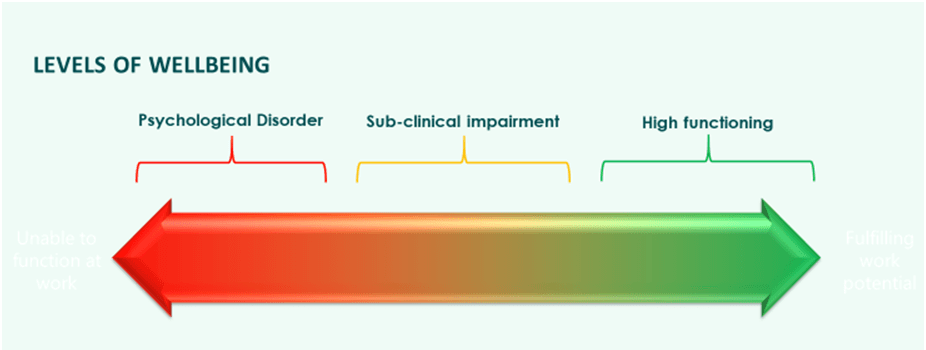The statistics of “one in four”, “one in five” or “one in seven” might mislead us into thinking mental ill-health is something that happens to others. The reality is that mental health exists on a continuum, with our wellbeing impacted every day.
Some people do seem to have high levels of psychological resilience and mental wellbeing, but for most people, the stresses of life can deliver a blow to their mental health that moves them from flourishing to floundering.

What if we called it “four in four” or “five in five” – acknowledging that just like our dental and physical health, none of us are immune from mental health issues?
Unlike our physical and dental health, mental health is often regarded as something we can manage ourselves. In the workplace, many managers do not have the skills or training to spot the early warning signs of ill health – the sub-clinical impairment. Or even if they do, should we expect them to have the ability to have a sensitive conversation? Stigma is an enormous challenge, even when organisations place great value on health and well-being at work.
Mental health is not confined to the workplace. Events outside of work – relationship breakdowns, deaths of family members, financial issues, health problems, challenges with children… any number of stressors outside of the workplace can impact mental health and reduce productivity in the workplace too – even for those in the high functioning range.
And the reverse is equally true. That the challenges of a role or workplace can impact mental health – and lead to profound difficulties outside of the workplace. Employees who work late, driven by unrelenting standards, losing sleep, neglecting relationships, neglecting other aspects of their health may appear high functioning, but are they? There can be a variety of unsustainable models of working that lead to burn out or stress. Unsustainable – but changeable models.
If we accept that mental wellbeing is something we should work together towards – accept that it affects everyone, and that it exists on a continuum – then it is important to understand how “mental wellbeing” can be accomplished. The work must be preventative, as well as responsive. Flexible to changing needs.
Making the decision that physical and mental health should be given equal priority is important, and a great first step. Raising awareness and reducing stigma is a must. Mental health must be actively discussed to help break down barriers.
Teaching resilience, recognising mental health as a core and central part of a healthy workforce – and a healthy society is important.
Understanding what mental health and wellbeing is – and is not, is a pivotal part of bringing change. Acknowledging that it is something that affects us all – not just some, is a perfect place to begin.







